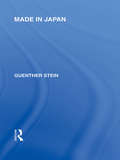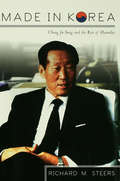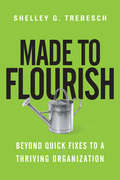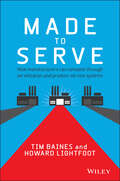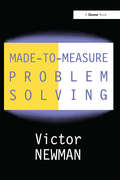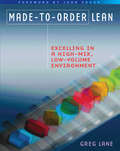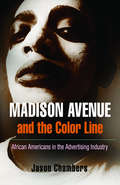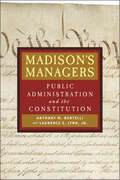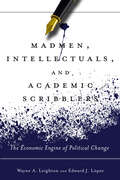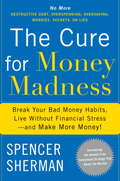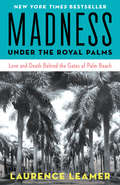- Table View
- List View
Made in Japan (Routledge Library Editions: Japan)
by Guenther SteinThis volume concentrates on the effect of Japanese trade competition on the UK and Europe, it also provides an illuminating picture of political, social and military conditions in Japan in the early twentieth century.
Made in Korea: Chung Ju Yung and the Rise of Hyundai
by Richard M. SteersAmerican business folklore is awash with the adventures of successful entrepreneurs. Still, most of these stories are about Americans, neglecting important and courageous entrepreneurs from other countries. Made in Korea recounts the story of how Chung Ju Yung rose from poverty to build one of the world's largest and most successful building empires - Hyundai - through a combination of creative thinking, tenacity, timing, political skills, and a business strategy that few competitors ever understood. Chung entered the shipbuilding business with no experience and went on to create the world's largest shipyard. He began making automobiles when foreign experts unanimously predicted he would fail, and he started a global construction company that has built some of today's greatest architectural wonders. He even convinced the International Olympic Committee to select South Korea over Japan as the site for the highly successful 1988 Olympics. Unlike most CEO's of major firms, Chung has always preferred the company of his workers to that of the global executive elite. Hard work, creativity and a capacity to never give up - this is the essence of Chung's life. In each of his ventures, he exhibited a sheer determination to succeed, regardless of the obstacles, and he worked tirelessly to instil this drive in all of his employees. Even today, in the midst of Korea's worst economic crisis in over four decades, Chung's company is busy implementing plans to emerge as an even stronger contender in the world economy. Illustrated with 32 pages of colour photographs not previously seen in the West, including photos of Chung's recent historic visit to North Korea in 1998, Made in Korea takes stock of Chung's entire life, highlighting both his contributions to society and the lessons his work can teach to aspiring entrepreneurs.
Made in Mexico: Regions, Nation, and the State in the Rise of Mexican Industrialism, 1920s–1940s
by Susan M. GaussThe experiment with neoliberal market-oriented economic policy in Latin America, popularly known as the Washington Consensus, has run its course. With left-wing and populist regimes now in power in many countries, there is much debate about what direction economic policy should be taking, and there are those who believe that state-led development might be worth trying again. Susan Gauss’s study of the process by which Mexico transformed from a largely agrarian society into an urban, industrialized one in the two decades following the end of the Revolution is especially timely and may have lessons to offer to policy makers today.The image of a strong, centralized corporatist state led by the Partido Revolucionario Institucional (PRI) from the 1940s conceals what was actually a prolonged, messy process of debate and negotiation among the postrevolutionary state, labor, and regionally based industrial elites to define the nationalist project. Made in Mexico focuses on the distinctive nature of what happened in the four regions studied in detail: Guadalajara, Mexico City, Monterrey, and Puebla. It shows how industrialism enabled recalcitrant elites to maintain a regionally grounded preserve of local authority outside of formal ruling-party institutions, balancing the tensions among centralization, consolidation of growth, and Mexico’s deep legacies of regional authority.
Made in USA: Cómo entender a los Estados Unidos
by Guy SormanSorman, periodista y ensayista francés, dibuja un panorama de losEstados Unidos desde el lugar de quien se pasea por ahí sin prisas. Su particular descubrimiento de América empieza en el año 1962 y terminaen 2004,locual permite al autor presentar y analizar un amplio abanicode cambios ocurridos en este período en los Estados Unidos y en cuanto ala actitud de Europa frente a ese país.
Made in the USA
by Vaclav Smil"There is probably no other writer whose books I anticipate with more enthusiasm than Vaclav Smil. He brings remarkable insight to every topic he examines, combining his vast knowledge of science and energy, history and business to address some of the most pressing issues we face today. So Im pleased he will be turning that keen intellect to the subject of manufacturing in the U. S. "--Bill GatesIn "Made in the USA," Vaclav Smil powerfully rebuts the notion that manufacturing is a relic of predigital history and that the loss of American manufacturing is a desirable evolutionary step toward a pure service economy. Smil argues that no advanced economy can prosper without a strong, innovative manufacturing sector and the jobs it creates. Reversing a famous information economy dictum, Smil argues that serving potato chips is not as good as making microchips. The history of manufacturing in America, Smil tells us, is a story of nation-building. He explains how manufacturing became a fundamental force behind Americas economic, strategic, and social dominance. He describes American manufacturings rapid rise at the end of the nineteenth century, its consolidation and modernization between the two world wars, its role as an enabler of mass consumption after 1945, and its recent decline. Some economists argue that shipping low-value jobs overseas matters little because the high-value work remains in the United States. But, asks Smil, do we want a society that consists of a small population of workers doing high-value-added work and masses of unemployed? Smil assesses various suggestions for solving Americas manufacturing crisis, including lowering corporate tax rates, promoting research and development, and improving public education. Will America act to preserve and reinvigorate its manufacturing? It is crucial to our social and economic well-being; but, Smil warns, the odds are no better than even.
Made in the USA: The Rise and Retreat of American Manufacturing (The\mit Press Ser.)
by Vaclav SmilAn argument that America's economy needs a strong and innovative manufacturing sector and the jobs it creates.“There's no author whose books I look forward to more than Vaclav Smil.”—Bill GatesIn Made in the USA, Vaclav Smil powerfully rebuts the notion that manufacturing is a relic of predigital history and that the loss of American manufacturing is a desirable evolutionary step toward a pure service economy. Smil argues that no advanced economy can prosper without a strong, innovative manufacturing sector and the jobs it creates. Smil explains how manufacturing became a fundamental force behind America's economic, strategic, and social dominance. He describes American manufacturing's rapid rise at the end of the nineteenth century, its consolidation and modernization between the two world wars, its role as an enabler of mass consumption after 1945, and its recent decline. Some economists argue that shipping low-value jobs overseas matters little because the high-value work remains in the United States. But, asks Smil, do we want a society that consists of a small population of workers doing high-value-added work and masses of unemployed? Smil assesses various suggestions for solving America's manufacturing crisis, including lowering corporate tax rates, promoting research and development, and improving public education. Will America act to preserve and reinvigorate its manufacturing? It is crucial to our social and economic well-being; but, Smil warns, the odds are no better than even.
Made to Flourish: Beyond Quick Fixes to a Thriving Organization
by Shelley G. TrebeschEvery organization is made to flourish. But when problems arise, quick fixes and poor leadership training can drag it down. The key to a thriving team is to look below the surface at the hidden dynamics that can cause it to lose focus, turn inward or even cease to exist. Budget problems, personality conflicts, mission drift, government regulations—all these and more can tempt us to respond rapidly and superficially. Shelley Trebesch offers leaders the tools needed to develop practical solutions that actually work. She provides a model for getting a firm hold on the complexities inherent in any team. Diagrams help readers visualize key dynamics while vivid case studies illustrate how to put the book into practice. Here is the book that gives churches, NGOs, mission agencies, parachurch groups, other nonprofits, businesses and teams within these groups what they need. Trebesch charts the path to the life-giving, holistic, fruitful abundance that God intended for organizations and everyone in them.
Made to Order: The Sheetz Story
by Kenneth WomackMade To Order: The Sheetz Story traces the fascinating history of Sheetz, Inc., a regional convenience retailer that battled the odds and cemented its name among the acclaimed ranks of America's most successful private companies. From its humble dairy store origins in Pennsylvania, Sheetz became a convenience-store giant, amassing hundreds of locations across six states, and along the way, combined numerous creative marketing campaigns with retail innovations to shape the Sheetz recipe for success. Made To Order: The Sheetz Story narrates how the company remade itself in the face of dramatically shifting demographics, bravely stood up for its customer base when confronted with a serious crisis, and emerged as a revered and much-beloved retail phenomenon.
Made to Play!: Handmade Toys and Crafts for Growing Imaginations
by Joel HenriquesDelight young children and encourage play through unique handmade toys. From sewn and stuffed musical instruments to interlocking paper building blocks and wooden animal figurines, the projects in this book are meant to encourage open-ended play. Organized by kid-loving subjects, the toys here follow the themes of Zoo; House; Blocks, Cars & Trucks; Dress-Up; Music; and Art. Overall, the projects here are meant to stimulate imagination, build confidence through success and enjoyment, and enhance the bond between family and friends through the creation of unique, artistic handmade toys and crafts. The thirty-five projects in this book include a variety of crafts, from drawing to sewing and light woodworking. The toys presented here are made out of wonderfully tactile materials—repurposed fabrics, wood, and paper—and invite opportunities for creative and imaginative play. Every project is easy to complete, made with accessible materials, and requires little time to make. The projects are simple enough that endless variation can come from the making of each, leaving enough room for you to make the item to suit your own personal interests. With a design aesthetic that is clean, simple, and modern, each project is presented with full-color photos and hand-drawn instructional illustrations and templates. Projects include: • Modern Doll House and Doll House Furniture • Portable Zoo Animals • Abstract Vertical Puzzle • Wooden Nature Scene • Bottle-Cap Tambourine • Exploration Cape • Modern Alphabet Game • Shadow Puppet Theater • And more!
Made to Serve
by Timothy Baines Howard LightfootA comprehensive, practical introduction to one of the most important new trends in manufacturing, globallyThe delivery of a service component as an added value when providing products, servitization is all the rage in the manufacturing sector around the world. Yet, despite the clear competitive advantage of servitization, most manufacturers remain reluctant to venture into, what for them, is a strange new world. Written by a team of internationally respected servitization experts and innovators, this book provides you with a detailed road map for successfully navigating the servitization terrain. Unlike most authors on the subject who merely sing the praises of servitization, Baines and Lightfoot provide you with a framework for accessing the feasibility of adopting a services-led competitive strategy in your company, along with strategies for designing and implementing the kinds of service offerings customers increasingly are coming to expect. Grounded in real-world practice and supported by a wealth of up-to-the minute research, this book helps ease the way for manufacturers considering adopting a servitization modelShows how to exploit your company's manufacturing competencies to build a strong servitization element without becoming "just another services company"Provides numerous illustrations and examples of services-led competitive strategies, with an emphasis on the advanced services most widely associated with servitization worldwidePacked with fascinating and instructive case studies from leading manufacturing firms across industry sectors, including Caterpillar, Rolls-Royce, Alstom, MAN, Xerox and others
Made to Stick: Why Some Ideas Survive and Others Die
by Chip Heath Dan HeathWhat is that makes urban myths so persistent but many everyday truths so eminently forgettable? How do newspapers set about ensuring that their headlines make you want to read on? And why do we remember complicated stories but not complicated facts? In the course of over ten years of study, Chip and Dan Heath have established what it is that determines whether particular ideas or stories stick in our minds or not, and Made to Stick is the fascinating outcome of their painstaking research. Packed full of case histories and thought-provoking anecdotes, it shows, among other things, how one Australian scientist convinced the world he'd discovered the cause of stomach ulcers by drinking a glass filled with bacteria, and how a gifted sports reporter got people to watch a football match by showing them the outside of the stadium.
Made-to-Measure Problem-Solving
by Victor NewmanDo you solve problems in the style of a coyote, competitor or eagle? Recognising the way you approach and deal with problems at work will enable you to identify the most suitable technique to use on a daily basis. Victor Newman’s practical book strikes at the heart of fundamental challenges faced by all managers. It looks beyond the conventional techniques of problem-solving to the underlying process, identifies eight stages and explains how to recognise which technique is appropriate to which stage. On this basis managers can generate solutions at both the personal and the organisational level. A unique feature of the book is a Problem Solving Styles Profile that enables each reader to apply the material in the text to improve their own problem-solving capability.
Made-to-Order Lean: Excelling in a High-Mix, Low-Volume Environment
by Greg LaneToyota Production System methods have rendered remarkable results in high-volume manufacturing plants, but they have not been fully understood and correctly applied in high-mix, low-volume environments. While lean principles do apply, the implementation methods and tools must be adapted and alternate methods embraced in a low-volume environment. This volume is specifically geared for manufacturers that have hundreds to thousands of active part numbers with few or no ongoing forecasted volumes, and for job shops that build only to order. The primary focus is eliminating non-value-added activities and instituting improvements on the most repetitive jobs, a strategy that gives you more time to produce your low-volume work or one-offs. About the author: Greg Lane is a faculty member of the Lean Enterprise Institute and an advisor to the Instituto de Lean Management in Spain. During his time with Toyota, he was one of a handful of candidates selected for a one-year training program conducted by the company’s masters. He became certified as a Toyota Production System (TPS) Key Person and continued his work with Toyota, training others in TPS. He has been highly active in working on implementing lean around the world, supporting large and small companies alike. In 1998, he began to focus his lean endeavors on meeting the specific needs of high-mix, low-volume enterprises. During his time as an independent consultant, Greg purchased and operated his own manufacturing company, which specialized in fast turnaround on high-mix, low-volume parts. Greg used TPS to grow the business and nearly double its sales. Greg and his associates have experience not only at adapting the methods contained in this book, but also in applying other tools that are too numerous to detail here. They can be reached for further support with your lean transformation via email: glane@lowvolumelean.com
Madison Avenue and the Color Line
by Jason ChambersUntil now, most works on the history of African Americans in advertising have focused on the depiction of blacks in advertisements. As the first comprehensive examination of African American participation in the industry, Madison Avenue and the Color Line breaks new ground by examining the history of black advertising employees and agency owners.For much of the twentieth century, even as advertisers chased African American consumer dollars, the doors to most advertising agencies were firmly closed to African American professionals. Over time, black participation in the industry resulted from the combined efforts of black media, civil rights groups, black consumers, government organizations, and black advertising and marketing professionals working outside white agencies. Blacks positioned themselves for jobs within the advertising industry, especially as experts on the black consumer market, and then used their status to alter stereotypical perceptions of black consumers. By doing so, they became part of the broader effort to build an African American professional and entrepreneurial class and to challenge the negative portrayals of blacks in American culture.Using an extensive review of advertising trade journals, government documents, and organizational papers, as well as personal interviews and the advertisements themselves, Jason Chambers weaves individual biographies together with broader events in U.S. history to tell how blacks struggled to bring equality to the advertising industry.
Madison Avenue: Digital Media Services (A)
by Steven J. Spear Jeremy B. DannIntroduces a "new-economy" company, Madison Avenue, facing challenges of mega-success. In the two years since its founding, the company's revenues have grown from zero to nearly $30 million, head count has swollen from the start-up handful to more than 200, and the client base has gone from one to dozens. In the company's short life, Madison Avenue's managers have already tried four organizational forms to more efficiently and reliably meet the needs of its customers. Despite the intense, ongoing efforts to find an appropriate organizational form, employees struggle to keep pace with ever-increasing demands. Ted Samson, an implementation engineer at Madison Avenue and a reservist in the Marine Corps, expresses a collective frustration in an e-mail to his boss. The case contains a history of Madison Avenue, starting with its serendipitous creation as an outgrowth of a family business's efforts to advertise on the Web and the collateral development of an expertise in Web advertising and the evolution of the company's business model. Gives a detailed explanation of the internal processes by which Madison Avenue creates, implements, and optimizes online advertising campaigns for its clients. The case asks students to analyze how Madison Avenue currently does its work and then to design a "target condition"--based upon analysis of the company's "current condition"--of how Madison Avenue's internal processes might be redesigned in order to produce higher quality ad campaigns, at less cost, with shorter lead-times, and with greater flexibility in responding to customer needs.
Madison Avenue: Digital Media Services (B)
by Steven J. Spear Anne D. KarshisIn late 1999, Madison Avenue was experiencing phenomenal growth in sales, clients, employees, and services provided. The stress and strain on the firm's employees was considerable and threatened to jeopardize the high-quality, active-ad management for which the firm was developing a positive reputation. From late 1999 through July 2000, the firm embarked on a number of initiatives to improve its internal processes so that it could scale successfully, meet the needs of its customers, maintain the quality of the services it provided, and improve efficiency enough to generate operating profits. The case describes the many efforts made within Madison Avenue to improve its processes.
Madison Avenue: Digital Media Services (C)
by Steven J. Spear Anne D. KarshisBy July 2000, Madison Avenue had experienced extraordinary growth in sales, employees, clients, and service offerings. From late 1999 to July 2000, the company had taken several initiatives to redesign its internal processes so that the firm could continue to grow, while maintaining the quality of its service offering and increasing efficiency enough to show profitability. Matt Garvin, the company's chief strategy officer, was considering a host of new service offerings to complement its core service--active management of online advertising. The question to Garvin was twofold: What opportunities made strategic sense for the company? What strategic opportunities matched well with the company's operational capabilities? How reliable, robust, and responsive are they? Can they handle the growth, scale, and scope that Garvin is contemplating. Can be taught alone as a strategy case or in conjunction with the (B) case to emphasize the product-process matching problem. If taught together, one case can be assigned to half the students, the other case to the other half to simulate more fully the organizational challenge of communicating across functional specialties--i.e., the service equivalent of product development, production, marketing, and sales.
Madison's Managers: Public Administration and the Constitution (Johns Hopkins Studies in Governance and Public Management)
by Anthony M. Bertelli E. Jr. LynnA case for the constitutional roots of public administration: “Essential to the field as we develop new theories and applications in a postmodern America.” ?Political Studies ReviewCombining insights from traditional thought and practice and from contemporary political analysis, Madison’s Managers presents a constitutional theory of public administration in the United States. Anthony Michael Bertelli and Laurence E. Lynn Jr. contend that managerial responsibility in American government depends on official respect for the separation of powers and a commitment to judgment, balance, rationality, and accountability in managerial practice.The authors argue that public management—administration by unelected officials of public agencies and activities based on authority delegated to them by policymakers—derives from the principles of American constitutionalism, articulated most clearly by James Madison. Public management is, they argue, a constitutional institution necessary to successful governance under the separation of powers. To support their argument, Bertelli and Lynn combine two intellectual traditions often regarded as antagonistic: modern political economy, which regards public administration as controlled through bargaining among the separate powers and organized interests, and traditional public administration, which emphasizes the responsible implementation of policies established by legislatures and elected executives while respecting the procedural and substantive rights enforced by the courts. These literatures are mutually reinforcing, the authors argue, because both feature the role of constitutional principles in public management.Madison’s Managers challenges public management scholars and professionals to recognize that the legitimacy and future of public administration depend on its constitutional foundations and their specific implications for managerial practice.
Madmen, Intellectuals, and Academic Scribblers: The Economic Engine of Political Change
by Wayne A. Leighton Edward J. LopezDoes major political reform require a crisis? When do new ideas emerge in politics? How can one person make a difference? In short: how and when does political change happen? Madmen, Intellectuals, and Academic Scribblers tackles these big questions, arguing that ideas and entrepreneurship are the key ingredients in any episode of political change. Authors Wayne A. Leighton and Edward J. López begin with the first lesson in economics -- incentives matter -- and artfully explain how the lesson applies throughout political life. Incentives explain why democracies often generate policies that impose net costs on society, and why these inefficient policies persist for years. Yet beneficial reform does sometimes occur. So Madmen goes beyond incentives to offer a framework in which political change channels its way from ideas in society, through society's shared institutions (i.e., its rules of the game), which then shape incentives. This type of change is seldom easy, because new ideas for shaping the rules of the game must overcome two forces in society: widely shared beliefs and powerfully vested interests. Yet at certain political moments - perhaps during a crisis, but not always - shared beliefs and vested interests begin to weaken, and the opportunity for reform emerges. Within this framework, Madmen shows why certain inefficient policies eventually get repealed (e.g., airline rate and route regulation), while others endure (e.g., sugar subsidies and tariffs). Drawing on the history of Western political ideas, both in theory and in practice, Madmen matches up three key ingredients - ideas, rules, and incentives - with the characters who make political waves: "madmen in authority" (such as Franklin Delano Roosevelt and Margaret Thatcher), "intellectuals" (like George Will or Jon Stewart), and "academic scribblers" (in the vein of Friedrich Hayek and John Maynard Keynes). Political change happens when these characters - called political entrepreneurs - notice areas of weakness in the structure of ideas, rules, and incentives, and then find ways to change the rules of the game in those areas. These entrepreneurs in political change may be philosophers, opinion makers, political leaders, or other types of influencers. What they have in common is an interest in better ideas--ones that improve the human condition--and a vision to change incentives and outcomes. Madmen helps leaders in business and politics, and opinion-makers everywhere, better understand where the next opportunities are emerging. Students and professors will eat up its history of ideas, from the Ancients Greeks to Adam Smith, and from the Progressives to modern political economy. Using the framework laid out by the authors, readers of all stripes will see how they can be entrepreneurs in promoting effective political change.
Madness
by Spencer ShermanSherman presents the tools that have helped thousands of people find greater peace of mind--and make more money.
Madness Under the Royal Palms: Love and Death Behind the Gates of Palm Beach
by Laurence LeamerLove, lust, and fatal hatreds inside America's most exclusive enclave of wealth and privilege--Palm Beach.Bernard Madoff's Ponzi scheme devastated the eternally sunny world of Palm Beach, bringing down multimillionaires and destroying once-wealthy widows. The South Florida island and its rarified life suddenly found itself at the epicenter of the scandal, with this strange universe of wealth and privilege under an unrelenting spotlight.Now, in Madness Under the Royal Palms, Laurence Leamer shows us--as no one else has--this world of the megawealthy, which he calls "as hidden a place as I have ever resided." Digging deep, he hits a dark well of conflicting ambitions--right up to and including murder--much darker than the sky-blue weather and sunny Lily Pulitzer prints most of us associate with Palm Beach.
Madoff with the Money
by Jerry OppenheimerAn intriguing look at Bernie Madoff the man, and his scam Madoff with the Money is a deeply disturbing portrait of Bernie Madoff based on dozens of exclusive, news-making interviews. From the values Madoff was taught growing up in the working class town of Laurelton, Queens to his high-life on Wall Street and the super-rich enclaves of Palm Beach and the French Riviera, bestselling author Jerry Oppenheimer follows the disgraced money manager's trail as he works his way up the social and economic ladder, and eventually scams his trusting clients in a $50 billion Ponzi scheme. Through Oppenheimer's in-depth reporting, you'll discover new revelations in this startling case, and become familiar with the trusting victims-ranging from non-profit Jewish charities to the likes of seemingly sophisticated individuals such as actress Jane Fonda who would "like to shake Madoff until his teeth fall out," the scion of the Baskin-Robbins ice cream empire who lost a bundle and was forced to rent out rooms in his house, and New Jersey Senator Frank Lautenberg. There's even Madoff's own sister-in-law and talk show host Larry King, who apparently didn't ask the right questions when he invested. All lost their much-needed life savings, while others saw fortunes small and large evaporate in the greedy financial operations of one of history's all-time charlatans. Madoff With the Money Delves into the details of the illusive man that lost investors billions Weaves stories of Madoff's past with those of the present in an engaging and accessible style Explores how the financial scam that Madoff ran cost individuals and institutions billions of dollars Other titles by Oppenheimer: Toy Monster: The Big, Bad World of Mattel, and Just Desserts: Martha Stewart the Unauthorized Biography While there may be other books on the Bernie Madoff debacle, none digs as deep or goes as far to uncover the truth behind the man, and his incredible scam.
Madoff: The Final Word
by Richard BeharRenowned investigative journalist Richard Behar delivers the definitive account of history&’s largest—and longest-running—financial fraud, &“the scale of the deception…beggars belief&” (New York Post).Some $68 billion evaporated during Bernie Madoff&’s epic confidence game. Two people were driven to suicide in the wake of the Ponzi Scheme&’s exposure. Others went to prison. But there has never been a satisfying accounting for how Bernie got away with so much, for so long. Until now. Richard Behar&’s relationship with Madoff began in 2011 with a simple email request from the conman. By the time Madoff died in 2021, he had sent Behar more than 300 emails and dozens of handwritten letters, participated in some fifty phone conversations, and sat for three in-person jailhouse interviews—a level of access provided to no other reporter. Behar also established relationships with hundreds of regulators, prosecutors, FBI agents, investors, Wall Street experts, ex-employees of Madoff&’s, family members, school classmates, and others. The result is the final word on the criminal behind history&’s most enduring fraud—and on those who believed him, covered for him, or locked him up. Behar illuminates not only the fraud&’s origins—decades earlier than Madoff claimed in his confession—but also the complicity of investors, Wall Street insiders, family members, and some of the largest banks in the US and Europe. Shocking, infuriating, riveting (and at times absurdly funny), Madoff shows us how Bernie ensnared thousands of investors. As Behar&’s dogged reporting over the last fifteen years makes clear, however, there aren&’t many innocents left standing by the end of this tale. Just about everyone involved is guilty, at a minimum, of humanity&’s most consistent weakness: greed.
